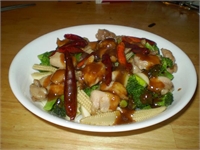
Tom’s Quasi Chinese Stir Fry Recipe
Important Notice: Our web hosting provider recently started charging us for additional visits, which was unexpected. In response, we're seeking donations. Depending on the situation, we may explore different monetization options for our Community and Expert Contributors. It's crucial to provide more returns for their expertise and offer more Expert Validated Answers or AI Validated Answers. Learn more about our hosting issue here.

Tom’s Quasi Chinese Stir Fry Recipe
You must be logged in to post a comment.
I am both a huge lover of Chinese food (among many ethnic varieties) and a dedicated sloth. This means that I either have to eat out a lot, or learn to cook the foods I love at home. My single favorite Chinese dish has always been kung pao chicken. I use this recipe to gauge every Chinese eatery in which I dine. If their kung pao isn’t good, I won’t be back.
The only problem was that there were always ingredients in the kung pao served to me that went uneaten. I am a picky eater in many regards, and while most Chinese restaurants do their kung pao a little differently, they all seem to feel the need to load it up with onions and bell peppers. I love cooking with these two ingredients, but I hate eating either. Some places put celery in the dish as well, and I don’t know many people who actually eat it. Raw celery at least has a little flavor; cooking it reduces the flavor to zilch. And while peanuts are the main ingredient to all kung pao, I never ate them because I’m no fan of this particular legume.
The only logical approach to my own recipe was to fill it with only the things that I like. Hence, the following is not a kung pao recipe, nor a Chinese recipe of any description that I know of, but my own creation. But it sure tastes Chinese to me.
For my recipe, you can use any meat or seafood—or go vegetarian and skip the meat altogether… a thing I would never consciously do. But if you’re a true vegetarian, omitting the meat won’t be enough: you can also substitute water for the chicken broth if you like or must, but the results won’t be as good. What I do is this so I’m always ready to cook: I buy a small beef roast and cut it into small squares just right for stir fry (about 1/2 inch on a side); when I buy pork spare ribs, I trim off the back flap of meat and anything else that doesn’t include a bone and dice it; I buy chicken thighs, bone them (which is a pain) and dice the meat—then I put a single serving’s worth of each of these meats into the smallest zipper bag available, making sure the packages are all very flat so they will defrost quickly, and store them in the freezer. I know that just about every kung pao chicken recipe calls for diced chicken breasts; trust me, it’s much better with thigh meat.
I know that nutritionists say not to use peanut oil, but for stir frying in a wok with appropriately high heat, you need oil that won’t smoke, which means peanut or grape seed oil.
You can use whatever veggies you like for this recipe, but be sure to start with those that take the longest to cook and add the ones needing the least cooking—like onions—at the end. The ones I list here are those that my wife and I prefer. You can use as many or as few veggies as you like. The more veggies you use, the more preparation time, but it’s worth it. If you use broccoli as I do, you can save time by doing this: place the pieces of cut broccoli into a bowl and cover with cold water. Just before beginning to stir fry, drain the water from the bowl and microwave the broccoli until it’s just becoming tender (about a minute in low-medium powered microwaves; no more than 30 seconds in powerful units). Otherwise, broccoli takes quite a while to cook via stir fry.
Ersatz Chinese Stir Fry (serves 2)
For this you will need:
The Sauce:
The Procedure: